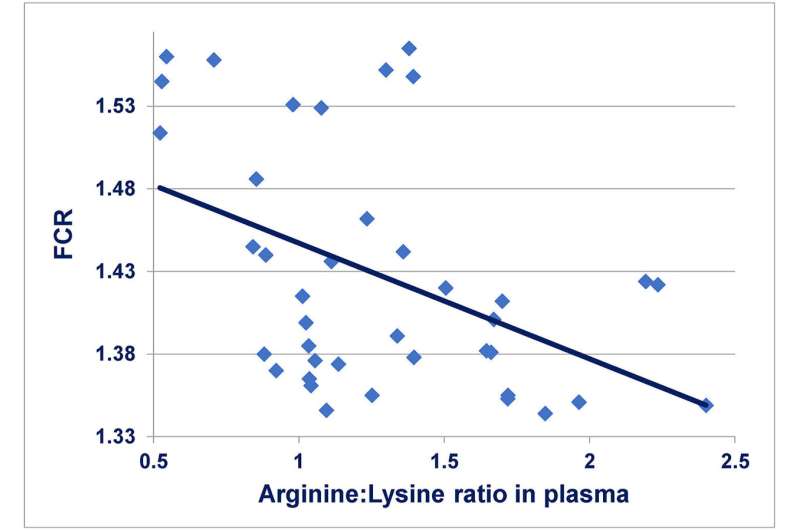This article has been reviewed according to Science X's editorial process and policies. Editors have highlighted the following attributes while ensuring the content's credibility:
fact-checked
proofread
Optimizing low-protein diets in broiler chickens: The role of grain type and dietary arginine to lysine ratio

Chicken-meat is one of the most accessible, affordable and accepted animal protein worldwide, presenting a promising solution to food security while maintaining minimal greenhouse gas emissions and low carbon footprints. Broiler chicken diets typically comprise 20 to 23% protein, with soybean meal being the primary protein source. Advancements have been made in the form of low-protein broiler diets, which reduce soybean meal usage by substituting with crystalline amino acids.
One main advantage of low-protein diets is the reduced nitrogen and ammonia pollution of the environment. It also contributes to better litter quality, which helps mitigate foot pad dermatitis. Furthermore, by offering broiler chickens low-protein diets, they become less susceptible to necrotic enteritis, a prevalent and financially devastating bacterial disease in modern broiler flocks.
Nevertheless, the successful development of low-protein diets presents a complex and genuine challenge due to its association with sub-optimal growth performance. To that end, a team of researchers in Australia and New Zealand conducted a comparative study, analyzing the efficacy of wheat and sorghum as the feed grain basis for both standard and reduced crude protein (CP) diets.
"We tested two main hypotheses: first, whether sorghum is a more suitable feed grain than wheat in reduced-CP diets, and second, whether elevated arginine:lysine ratios would enhance the performance of broiler chickens when offered reduced-CP diets," shared study's corresponding author Sonia Yun Liu.
The researchers discovered that exploring an increased dietary arginine to lysine ratio could serve as a potential strategy to promote reduced-CP broiler diets. Interestingly, elevating the dietary arginine:lysine ratio from 104 to 110 did not lead to the restoration of poor performance in broilers on low-protein diets.
However, there were notable differences based on the grain type used. Increasing the dietary arginine:lysine ratio proved beneficial for enhancing the growth performance of broilers on low-CP, sorghum-based diets. On the other hand, this similar strategy negatively affected the growth performance of broilers offered wheat-based, reduced-CP diets.
The team published their findings in Animal Nutrition.
"Our findings highlight that sorghum proves to be a more suitable feed grain than wheat in low protein broiler diets, as indicated by the significant CP × feed grain interaction (P = 0.013)," added Liu. "Broilers offered sorghum-based diets showed a notable advantage, with a 2.41% greater increase in weight gain than those on wheat-based diets at 210 g/kg CP levels. This advantage further expanded to 7.59% at 170 g/kg CP levels."
The authors recommend further study to understand these interactions for enhanced broiler production and better utilization of low protein diets, contributing to the sustainable development of the poultry industry.
More information: Shemil P. Macelline et al, The influence of dietary crude protein concentrations, grain types and arginine:lysine ratios on the performance of broiler chickens, Animal Nutrition (2023). DOI: 10.1016/j.aninu.2023.05.007
Provided by TranSpread


















